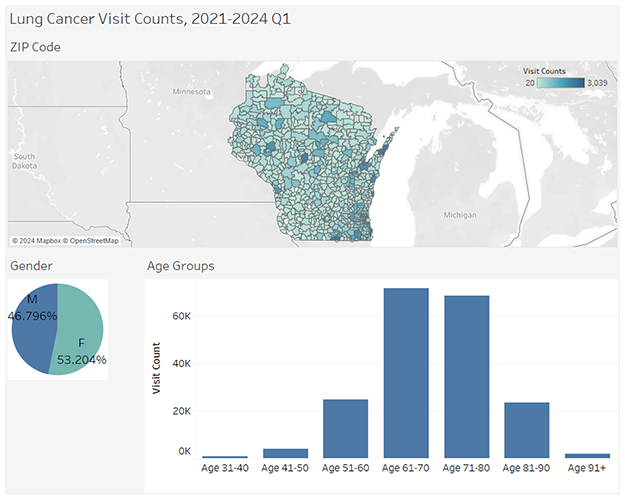Click here to view past issues
IN THIS ISSUE
- CMS Issues Final Outpatient Rule with new COPs for Obstetrical Services and Slightly Enhanced Payment Rates
- CMS Grants Flexibility for Rural Health Clinics as WHA Meets with NRHA and AHA to Discuss RHC Advocacy
- Wisconsin Hospitals State PAC & Conduit Update
- WHA Foundation Presents 2024 Global Vision Community Partnership Awards
- Fast Facts from the WHA Information Center: November is Lung Cancer Awareness Month
EDUCATION EVENTS
Jan. 14, 2026
Caring for Wisconsin’s Caregivers Well-Being First Champion Challenge for Credentialing KickoffJan. 28, 2026
2026 WHA Health Care Leadership AcademyFeb. 25, 2026
2026 Advocacy DayClick here to view education event calendar
View more issues of The Valued Voice
Sign Up for WHA's Newsletter
Fast Facts from the WHA Information Center: November is Lung Cancer Awareness Month
Lung cancer is the deadliest form of cancer, killing more people than breast, colon and prostate cancer combined. To help spread the word and educate people on the importance of lung cancer, November is Lung Cancer Awareness Month. 1 in 16 Americans will be diagnosed with lung cancer in their lifetime. According to the Centers for Disease Control and Prevention, lung cancer is the third most diagnosed cancer in both men and women in the United States. In 2021, the latest year incidence data was published, the U.S. reported more than 209,000 new cases of lung cancer. 1 in 16 Americans will be diagnosed with lung cancer in their lifetime.
The WHA Information Center analyzed all lung cancer diagnosis claims from 2021 through March 2024. In this timeframe, 2021 Q2 held the highest number of visits for lung cancer at roughly 15,000. Visit counts were higher in females than males. Outpatient services saw the highest visit counts for place of service. The highest age group of lung cancer visits is 61-70 years old with the median age being 70. Nationally, the median age of a lung cancer diagnosis is 72 years old. The county with the highest number of visits is Milwaukee County. The ZIP code with the highest number of visits for lung cancer is found in Door County.
 Lung cancer rates have been decreasing nationally the past few years as less people smoke cigarettes today than in the past and lung cancer treatments have improved. Smoking cigarettes is still the number one cause of lung cancer, but other tobacco products such as pipes or cigars still have a large impact on the lungs. Other risk factors of lung cancer include having a family history, breathing in secondhand smoke, or being exposed to substances such as radon or asbestos.
Lung cancer rates have been decreasing nationally the past few years as less people smoke cigarettes today than in the past and lung cancer treatments have improved. Smoking cigarettes is still the number one cause of lung cancer, but other tobacco products such as pipes or cigars still have a large impact on the lungs. Other risk factors of lung cancer include having a family history, breathing in secondhand smoke, or being exposed to substances such as radon or asbestos.
Center for Disease Control and Prevention recommends the following to help communities lower lung cancer risk:
- Implementing tobacco control programs to help prevent and reduce tobacco use
- Community preventive services task force to help people quit using tobacco, prevent minors from using, and avoid exposure to secondhand smoke
- Introducing evidence-based cancer control programs to encourage people to be screened for lung cancer
Fast Facts from the WHA Information Center: November is Lung Cancer Awareness Month
Lung cancer is the deadliest form of cancer, killing more people than breast, colon and prostate cancer combined. To help spread the word and educate people on the importance of lung cancer, November is Lung Cancer Awareness Month. 1 in 16 Americans will be diagnosed with lung cancer in their lifetime. According to the Centers for Disease Control and Prevention, lung cancer is the third most diagnosed cancer in both men and women in the United States. In 2021, the latest year incidence data was published, the U.S. reported more than 209,000 new cases of lung cancer. 1 in 16 Americans will be diagnosed with lung cancer in their lifetime.
The WHA Information Center analyzed all lung cancer diagnosis claims from 2021 through March 2024. In this timeframe, 2021 Q2 held the highest number of visits for lung cancer at roughly 15,000. Visit counts were higher in females than males. Outpatient services saw the highest visit counts for place of service. The highest age group of lung cancer visits is 61-70 years old with the median age being 70. Nationally, the median age of a lung cancer diagnosis is 72 years old. The county with the highest number of visits is Milwaukee County. The ZIP code with the highest number of visits for lung cancer is found in Door County.
 Lung cancer rates have been decreasing nationally the past few years as less people smoke cigarettes today than in the past and lung cancer treatments have improved. Smoking cigarettes is still the number one cause of lung cancer, but other tobacco products such as pipes or cigars still have a large impact on the lungs. Other risk factors of lung cancer include having a family history, breathing in secondhand smoke, or being exposed to substances such as radon or asbestos.
Lung cancer rates have been decreasing nationally the past few years as less people smoke cigarettes today than in the past and lung cancer treatments have improved. Smoking cigarettes is still the number one cause of lung cancer, but other tobacco products such as pipes or cigars still have a large impact on the lungs. Other risk factors of lung cancer include having a family history, breathing in secondhand smoke, or being exposed to substances such as radon or asbestos.
Center for Disease Control and Prevention recommends the following to help communities lower lung cancer risk:
- Implementing tobacco control programs to help prevent and reduce tobacco use
- Community preventive services task force to help people quit using tobacco, prevent minors from using, and avoid exposure to secondhand smoke
- Introducing evidence-based cancer control programs to encourage people to be screened for lung cancer
IN THIS ISSUE
- CMS Issues Final Outpatient Rule with new COPs for Obstetrical Services and Slightly Enhanced Payment Rates
- CMS Grants Flexibility for Rural Health Clinics as WHA Meets with NRHA and AHA to Discuss RHC Advocacy
- Wisconsin Hospitals State PAC & Conduit Update
- WHA Foundation Presents 2024 Global Vision Community Partnership Awards
- Fast Facts from the WHA Information Center: November is Lung Cancer Awareness Month

